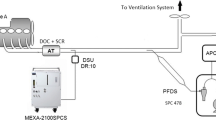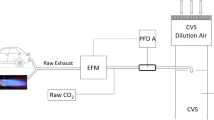Abstract
Particulate matter (PM) mass measurement methodologies were improved considerably with the application of Title 40 Code of Federal Regulations Part 1065 for the 2007 standards for heavy-duty engines that emphasized PM. However, there is still a need to improve the understanding of and the confidence in mass measurements for light-duty vehicles, which are now being subjected to more stringent PM standards. The purpose of this study is to evaluate commercially available partial flow dilutors (PFDs), with a particular focus on their equivalency with the standard constant volume sampler (CVS) tunnel method and the ability to provide reproducible measurements at low PM emission levels. For the main PFD comparison, simultaneous testing was conducted with the three PFDs, over federal test procedure (FTP) and US06 tests. The results of the calibrations and proportionality tests all showed good performance for the PFDs. The exhaust flow meters (EFMs) for the PFDs showed measurements within 2% or less of a calibration source. The PFDs also showed good level proportionality and can easily meet the CFR 1066 requirements for light-duty vehicles and 1065 requirements for all tests performed. Larger differences were seen for the main comparisons between the CVS and the different PFDs during the FTP testing, with the relative difference of PM emissions between the PFDs and the CVS varying from − 16.5 to − 0.6%, with an average pooled difference of − 8.5%. These FTP differences only represented 0.00 to 0.11 mg/mile on an absolute basis, however, and could be attributed to difficulties making and weighing filter mass measurements at such low levels. For the US06 cycle, the differences between the PFDs and the CVS were not statistically significant and ranged from − 6.7 to − 0.7% and up to 0.07 mg/mile.




Similar content being viewed by others
Abbreviations
- σ:
-
Standard deviation
- Bag:
-
Phase of the FTP bag measurement system
- CE-CERT:
-
College of Engineering-Center for Environmental Research and Technology (University of California, Riverside)
- CFR:
-
Code of Federal Regulations
- CO:
-
Carbon monoxide
- CO2 :
-
Carbon dioxide
- CVS:
-
Constant volume sampling
- DF:
-
Dilution factor
- EC:
-
Elemental carbon as defined by NIOSH methods
- EFM:
-
Exhaust flow meter
- EPA:
-
United States Environmental Protection Agency
- E10:
-
Ten percent ethanol in gasoline blend by weight
- FFV:
-
Filter face velocity
- FTP:
-
Federal test procedure
- GDI:
-
Gasoline direct injection
- ID:
-
Inner diameter
- ISO:
-
International Organization for Standardization
- LDVS:
-
Light-duty vehicles
- LEV:
-
Low-emission vehicle
- MFC:
-
Mass flow controller
- NIOSH:
-
National Institutes of Safety and Health method
- NIST:
-
National Institute for Standards and Technology
- OC:
-
Organic carbon
- OD:
-
Outer diameter
- PFD:
-
Partial flow dilution system
- PM:
-
Particulate matter
- PTFE:
-
Polytetrafluoroethylene
- SEE:
-
Standard error estimate
- US06:
-
US06 test cycle
References
Foote, E., Maricq, M., Sherman, M., Carpenter, D., et al.: Evaluation of partial flow dilution methodology for light duty partiulate mass measurement. SAE Tech. Pap. 2013-01-1567 (2013). https://doi.org/10.4271/2013-01-1567
Khalek, I., Ullman, T., Shimpi, S., Jackson, C., et al.: Performance of partial flow sampling systems relative to full flow CVS for determination of particulate emissions under steady-state and transient diesel engine operation. SAE Technical Paper 2002-01-1718 (2002). https://doi.org/10.4271/2002-01-1718
Sun, E., McMahon, W., Peterson, D., Wong, J., et al.: Evaluation of an enhanced constant volume sampling system and a bag mini diluter for near zero exhaust emission testing. SAE Technical Paper 2005-01-0684 (2005). https://doi.org/10.4271/2005-01-0684
Schweizer, T., Stein, H.: A new approach to particulate measurement on transient test cycles: partial flow dilution as alternative to CVS full flow systems. SAE Technical Paper 2000-01-1134 (2000). https://doi.org/10.4271/2000-01-1134
Thiel, W., Hornreich, C., Mörsch, O., and Seifert, G.: Problems of partial sample systems for modal raw exhaust mass emission measurement. SAE Technical Paper 2003-01-0779 (2003). https://doi.org/10.4271/2003-01-0779
Mishra, P., Iyer, S., Klinikowski, D.: Uncertainties in emissions measurements in a partial flow sampling system. SAE Technical Paper 2015-26-0096 (2015). https://doi.org/10.4271/2015-26-0096
CFR, Code of Federal Regulations, 40 Parts, PART 1065—engine-testing procedures. Available at: http://www.ecfr.gov/cgi-bin/text-idx?tpl=/ecfrbrowse/Title40/40cfr1065_main_02.tpl (2011)
Khalek, I.A.: 2007 Diesel particulate measurement research; Coordinating Research Council (CRC) report E-66 phase 1; CRC: Alpharetta (2005). Available at http://www.crcao.org/publications/emissions/index.html
Khalek, I.A.: 2007 Diesel particulate measurement research; Coordinating Research Council (CRC) report E-66 phase 2; CRC: Alpharetta (2006). Available at http://www.crcao.org/publications/emissions/index.html
Khalek, I.A.: 2007 diesel particulate measurement research; Coordinating Research Council (CRC) report E-66 Phase 3; CRC: Alpharetta, (2007). Available at http://www.crcao.org/publications/emissions/index.html
U.S. Environmental Protection Agency: EPA proposes tier 3 tailpipe and evaporative emission and vehicle fuel standards. Office of Transportation and Air Quality, EPA-420-F-13-018a (2013). Available at: http://www.epa.gov/otaq/documents/tier3/420f13018a.pdf
CARB: Staff report: LEV III PM, technical support document—development of particulate matter mass standard for future light-duty vehicles. (2012)
CFR, Code of Federal Regulations, 40 Parts, PART 1066—Vehicle-testing procedures. Available at: http://www.ecfr.gov/cgi-bin/text-idx?tpl=/ecfrbrowse/Title40/40cfr1066_main_02.tpl (2012)
Ntziachristos, L., Samaras, Z.: The potential of a partial-flow constant dilution ratio sampling system as a candidate for vehicle exhaust aerosol measurements. J. Air Waste Manage. Assoc. 60(10), 1223–1236 (2010). https://doi.org/10.3155/1047-3289.60.10.1223
Xue, J., Johnson, K., Durbin, T., Russell, R., et al.: Very low particle matter mass measurements from light-duty vehicles. Submitted Aerosol Science and Technology, July 2017
Hood, J.F., Silvis, W.M.: Predicting and preventing water condensation in sampled vehicle exhaust for optima CVS dilution. SAE Tech. Pap. 1, 1998-02-23 (1998). https://doi.org/10.4271/980404
Maricq, M.M., Chase, R.E., Podsiadlik, D.H., Vogt, R.: Vehicle exhaust particle size distributions: a comparison of tailpipe and dilution tunnel measurements. SAE Tech. Pap., 1999-01-1461 (1999). https://doi.org/10.4271/1999-01-1461
Kittelson, D., Arnold, M., Watts, W.F.: Final report: review of diesel particulate matter sampling methods. Available at: http://www.me.umn.edu/centers/cdr/reports/EPAreport3.pdf
Maricq, M., Szente, J., Harwell, A., Loos, M.: Impact of aggressive drive cycles on motor vehicle exhaust PM emissions. J. Aerosol Sci. 113, 1–11 (2017). https://doi.org/10.1016/j.jaerosci.2017.07.005
Acknowledgments
The authors acknowledge Mr. Mark Villela, Mr. Daniel Gomez, Mr. Kurt Bumiller, and Mr. Edward O’Neil of the University of California, Riverside, for their contributions in conducting the emissions testing for this program. The authors acknowledge Ms. Lauren Ackock and Ms. Grace Johnson for their contributions in filter weighing.
Funding
The authors acknowledge funding from the Coordinating Research Council under the E-99-2 project.
Author information
Authors and Affiliations
Corresponding author
Ethics declarations
The authors declare that they have no competing interests.
Electronic supplementary material
ESM 1
(DOCX 1238 kb)
Rights and permissions
About this article
Cite this article
Pham, L., Yang, J., Johnson, K. et al. Evaluation of Partial Flow Dilution Systems for Very Low PM Mass Measurements. Emiss. Control Sci. Technol. 4, 247–259 (2018). https://doi.org/10.1007/s40825-018-0099-1
Received:
Revised:
Accepted:
Published:
Issue Date:
DOI: https://doi.org/10.1007/s40825-018-0099-1




